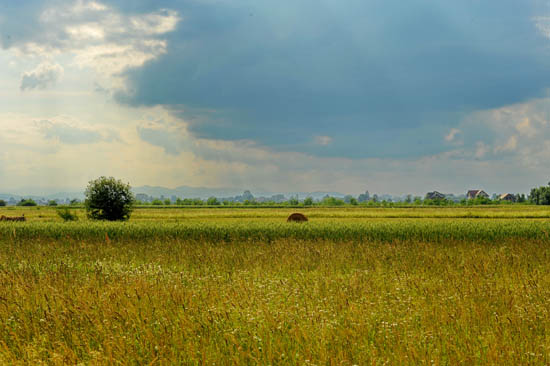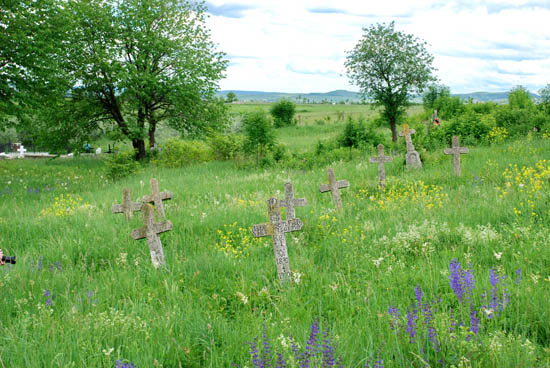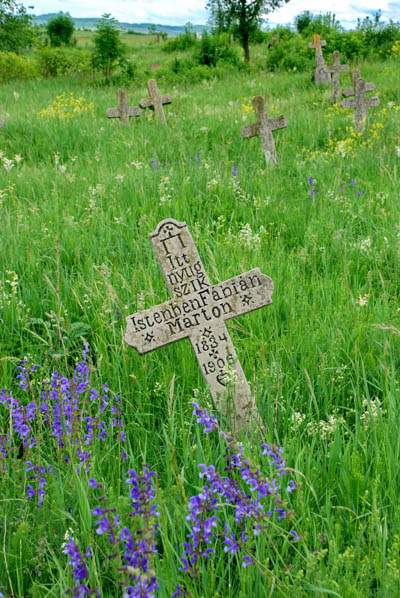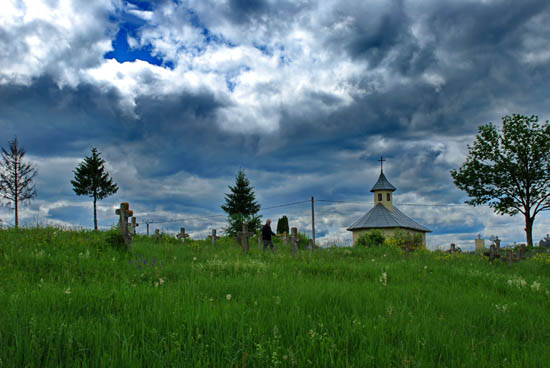
 Măneuți to reach the Ukrainian border.
Măneuți to reach the Ukrainian border.The dirt road leads through spacious fields, across the fertile plains of the Suceava river. In the distance, not so far away, you can see the edge of the bowl from where you came down, the range of the Carpathians. To the right, the meandering line of the Suceava, accompanied by willow groves. Flocks of sheep graze on the floodplain. At the edge of the village, long before you reach the first houses, a small cemetery to the right. We stop.
The graves are oddly grouped in this cemetery. At the far end, nearst the village, where there is also a second gate, there are some rows of tombstones with Romanian inscriptions. Parallel to the road, two or three more rows of Romanian tombstones, very fresh ones. The largest central part of the cemetery is covered with tall grass. Concrete crosses emerge from the grass. On them, Hungarian inscriptions.


The crosses all look towards the road, they turn their backs on the village. The Romanian tombs on the other side face the village. It seems that the Romanians, who settled here after the war, began to use the side of cemetery opposite from the pre-war residents. This is what saved the crosses from destruction. They were overgrown with grass and scrub, and while those made of wood have certainly rotted away, nevertheless the great invention of the village, the reinforced concrete crosses cast in the 1920s and 1930s, have survived. By 1990s, they also started to use the side of the cemetery towards the road, and it was all cleaned up, but the times when it was usual to destroy the former Hungarian, German or Polish graves without a trace had by that time passed. Unlike the cemeteries of the other four Hungarian villages in Bukovina, Józseffalva, Hadikfalva, Istensegíts and Fogadjisten, that of Măneuți – Andrásfalva – has remained, as the only memento of the former Bukovina Székely settlements.

 Two hundred fifty-two years ago today, on 7 January 1764 the Austrian imperial army started to fire cannons at the Hungarian Székelys gathered for the deliberation in Eastern Transylvanian Madéfalva (today Siculeni, Romania), because they refused to join the newly established Székely border regiments. Two hundred people died, thousands fled across the mountains to Moldavia, where they either increased the population of the Hungarian settlements in Gyimes and the Csángós of Moldavia, or scattered among the Romanian villages. When, ten years later, in 1774, Austria, in exchange for its neutrality in the Russian-Turkish war, obtained the northernmost region of the Turkish vassal Moldavia, from which they created the province of Bukovina, the new, Hungarian governor, General András Hadik noticed the large number of Hungarians living in the region, and collected them into five villages that were established for them.
Two hundred fifty-two years ago today, on 7 January 1764 the Austrian imperial army started to fire cannons at the Hungarian Székelys gathered for the deliberation in Eastern Transylvanian Madéfalva (today Siculeni, Romania), because they refused to join the newly established Székely border regiments. Two hundred people died, thousands fled across the mountains to Moldavia, where they either increased the population of the Hungarian settlements in Gyimes and the Csángós of Moldavia, or scattered among the Romanian villages. When, ten years later, in 1774, Austria, in exchange for its neutrality in the Russian-Turkish war, obtained the northernmost region of the Turkish vassal Moldavia, from which they created the province of Bukovina, the new, Hungarian governor, General András Hadik noticed the large number of Hungarians living in the region, and collected them into five villages that were established for them.In the fertile plains, the population of the villages rapidly grew, and the around ten thousand young people swarming from here from the 1880s onward established a number of new settlements, not only in Transylvania, but even in Canada and Brazil. However, their greatest journey started in 1941, when the Hungarian government resettled almost the entire population of the five villages to the fertile Bácska region, which in 1941 returned from Yugoslavia to Hungary. From there in 1944 they had to flee the Serbian partisans, up to Zala county in Transdanubia. Finally they were settled down in Tolna and Baranya counties, ironically in the houses of the displaced Swabians. Their long journey has been portrayed in the two-part film Sír az út előttem (The road is crying in front of me, 1987) by Sándor Sára.
And their former houses in Bukovina were occupied by Romanian refugees from Bessarabia, annexed in 1940 by the Soviet Union. Their Catholic churches were converted into Orthodox ones. Only a few Hungarians remained in the five villages. The descendants of the Bukovina Székelys living in Tolna, who have come here from time to time to put the Hungarian graves in order, met with them for the last time in the 1990s.

Two laments from Gyimes (Péter Hámori, Zsófia Lázár, 2006)




























































No hay comentarios:
Publicar un comentario